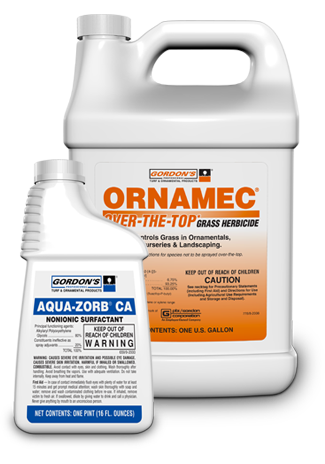ORNAMEC OVER-THE-TOP
Use Ornamec OTT To Control
Bermuda Grass In A Fescue Lawn
Ornamec OTT, made by PBI Gordon, is a systemic herbicide and it is a selective weed killer.
It controls annual and perennial grassy type weeds.
It was designed for, and is primarily used, in areas of ornamental plants, which would be broadleaf shrubs, flowers and such.
It is also labeled to Control Bermuda Grass in Tall Fescue Turf, as well as in Zoysia Grass. More specifically from the label:
“ORNAMEC may also be used to suppress and eventually control some undesirable grasses in turf areas.” (Empasis added.)
Two important points to know about this statement:
1) ‘Control bermuda’ is not the same as killing bermuda grass. (Think of your kids being ‘controlled’ going to the grandparents’ house for a Christmas holiday gathering. Control is a very ‘relative’ term.)
2) It is safe to use this grass killer on your fescue grass lawn, ONLY IF you follow the instructions for the specific dosage to use, and can handle some pain yourself.
Why The Concern?
The
OTT label states that there will be some discoloration to the fescue,
but it should be able to recover in 10-14 days.
What does that mean?
It
is going to mess up the exposed portion of fescue, but the grass will
continue to grow. By the second mowing after you spray, the damaged
stuff will have been pushed up far enough to be cut off.
So do NOT mix the Ornamec spray any stronger then recommended, thinking that killing bermuda grass will happen more quickly. It could be the fescue that bites the dust with too strong of a chemical.
(And as an afterthought, do not spray OTT on your lawn if you are going to have a garden party or some fancy shindig in your yard sooner than 2 weeks after spraying, unless you want to lose the yellow bocce ball in the yellow turf!)
FTC Disclosure:
If you make a purchase via a link on this site, I may receive a small commission on the transaction - at no added cost to you.
|
How Fast Does Ornamec Work? You can expect the grassy weeds to stop growing in about 48 hours or so. However it will take 1 to 3 weeks before the bermuda grass actually looks dead. This is a variable that can be affected by climate. Hot, dry weather can hasten the demise. Cool, moist weather may stretch out the time for brown-out. So don't draw the wrong conclusion if it's not brown or shriveled up the next day. |
 |
How Well Does It Work?
The label indicates that it is a process over one or two growing seasons to wipe it out. The effectiveness after a single spraying is difficult to tell. Each yard situation is different. Check out this article How To Identify Bermuda Grass to learn how the various parts of this weed (especially rhizomes) give it such an advantage and make it so difficult to kill.
You would have to dig down to check out some rhizomes to see if they have started to shrivel, wither or vanish. They may just have a tummy-ache, depending on their size and constitution. Even if you dug one up, you wouldn’t have anything to compare it to.
So just expect that the typical scenario is that mature rhizomes will be negatively impacted, but not dead yet. In a matter of time, the stronger ones will likely push out some new growth. New runners above ground indicate that it is time to treat again, rather than concluding it did not work at all.
How Often Is The Ornamec Treatment Applied?
The long term process for killing bermuda grass (or trying to) with OTT acknowledges the need for multiple applications during the growing season and probably through more than one growing season.
Spray the first time after the bermuda comes out of dormancy. It should be fully green. This might be April to May, or even earlier in some locations.
Repeat applications can be done at 14 to 21 day intervals.
Waiting longer than 3 weeks to respray allows the plant to strengthen its reserves, especially the underground rhizomes.
But judge this factor based on how much new top-growth you see. Most important is to hit it again before the new growth can put out seed stalks.
Avoid spraying during the summer months, or at any time that presents an abnormal hot spell (above 85-90 degrees).
Fescue is a cool-season grass and does not grow as actively in the summer months. You don’t want to over-stress it by applying such a strong herbicide when it is not at its peak performance level.
How Is The Product Used?
This is the part you may dread.
- OTT is a concentrate and must be mixed with water and sprayed on. Do NOT use a hose-end sprayer, only a tank-type sprayer. The label gives instructions for applying to acreage OR for spot treatment.
- Use the Spot Treatment Rate, even if you plan to spray your whole yard. (Just think of it as a big spot on your gardening resume until you get this bermuda wiped out. ...Or, you can loosely quote Shakespeare with a paraphrased line from Macbeth: “Out! Out, Bermuda Spot!”)
- Use 1 Tablespoon of Ornamec OTT, PLUS 2 Teaspoons of a nonionic surfactant, mixed into one gallon of water. The surfactant sometimes gets packaged and sold with the herbicide. Buy it separately if not included, and use the surfactant.
- Measure it accurately, and spray it as told. The one gallon of mixed spray is intended to cover a 1,000 square foot area.
Oh???
Yes, I know. Royal pain. How are you supposed to figure that out?
The only way to do that correctly is to have a trial run.
Mark off in your yard an area of 1,000 square feet, which could be 100 ft by 10 ft, or 50 x 20, or 40 x 25.
Fill up a sprayer with one gallon of clean water only, (no herbicide), and go spray. One gallon sprayers typically can cover that area, but it depends on how wide open the sprayer nozzle is, and how fast you move the wand, and your body.
Don't be self-conscious, just pay attention to how fast you must move to get the area sprayed before you run dry.
That is a simple approach that most homeowners can follow to get a fairly accurate application. For a more technical, professional understanding, use this Sprayer Calibration Guide offered by PBI Gordon.
Anything Else To Know?
- WATERING. It’s a good idea to water the lawn a day or two prior to spraying. Do not water again till the next day after spraying.
- RAINFAST. The marketing material says ‘Rainfast in one hour’, but I wouldn’t cut it that close if you have a storm headed your way.
- KEEP OFF THE GRASS. The “Restricted-Entry-Interval” is four hours, so keep kids and pets off the treated area for at least that long.
- MOWING. Do not mow until the second day after treatment, to allow the chemical to fully translocate throughout the plant.
- SHOPPER ALERT! Ornamec comes in two different strengths. The stronger OTT version explained in this article has 6.75% active ingredient (Fluazifop-P-butyl). A less expensive version, Ornamec 170, is only 1.7% active ingredient.
- BEST VALUE. Buy the 170 product only if you have a very small area to treat. But be aware, the dosage is VERY different! You must mix 2 fluid ounces (4 tablespoons) of the 170, instead of only 1 tablespoon with the stronger product. OTT is cheaper for a multiple application process.
- SURFACTANT. Use it. A separate bottle of surfactant may be included from some suppliers. Include this factor when comparing prices. (Side-note: A surfactant is pre-blended into the soft dose Ornamec 170)
DISCLAIMER: One last word on using Ornamec for killing bermuda grass in fescue:
Please read the label and if you don’t understand any part of the application instructions or the warnings, get assistance before you spray.
AND... Since Products Change & Formulas Change & Instructions Change, Please, Be Aware:
The directions and explanations in this article
might NOT apply to the actual product you have now or may purchase and may not be up-to-date... SO...
ALWAYS READ THE LABEL
& KEEP IT WITH THE PRODUCT
& REFER TO IT PRIOR TO USE.
Thank You!
Is this the best thing to use?
Good question. Check out the full series of articles on this topic. Get more information about this invasive weed, how it grows, and how to get rid of bermuda in different areas of your yard and garden.
Be concerned. It is a chemical. Be safe and prudent.
RELATED ARTICLES
Go to Killing Bermuda Grass in Fescue Lawns
Go to How To Kill Bermuda Grass for general information and a listing of all articles in this series.
Go to Top of Page
Go to Home Page of Lawn Care




